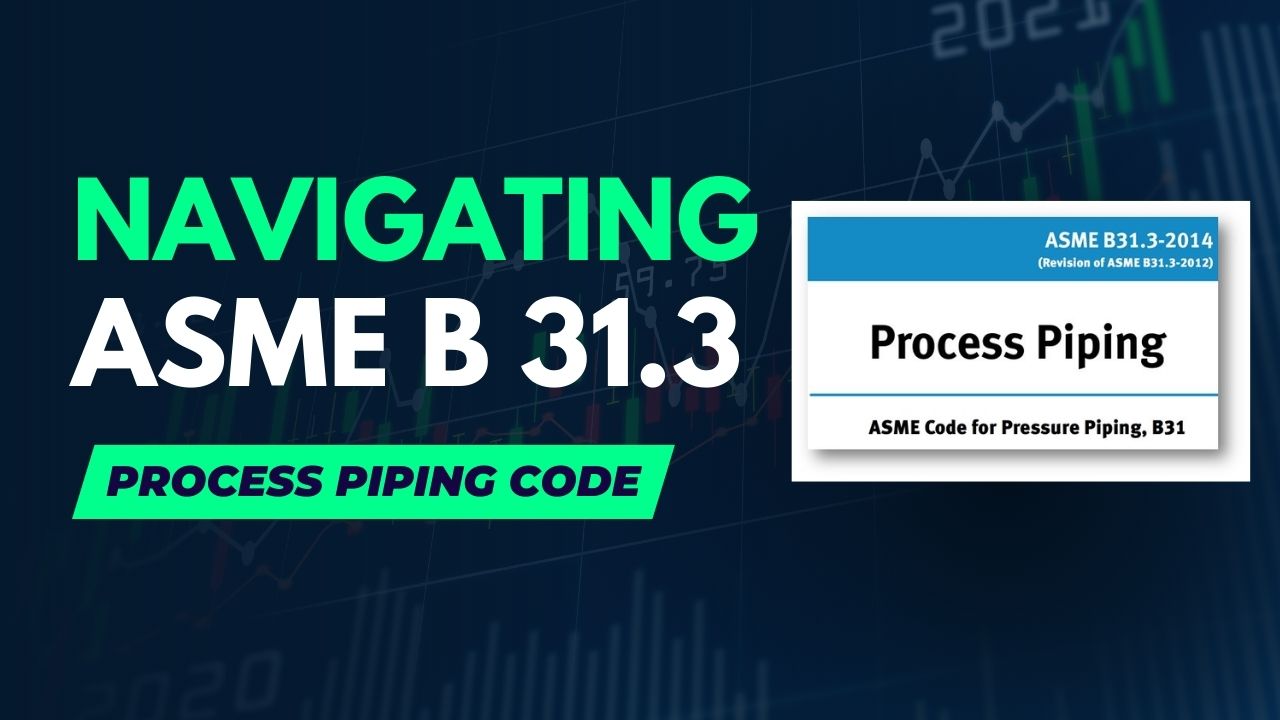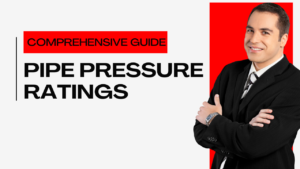Introduction
When it comes to the seamless transport of fluids and gases in industrial applications, a robust and well-designed piping system is crucial. The ASME B 31.3 code is the go-to standard for process piping design. In this comprehensive guide, we’ll explore the various facets of ASME B 31.3, its significance, and its impact on industries worldwide.
The ASME B 31.3 standard encompasses guidelines for the design, fabrication, inspection, testing, and operation of process piping systems. It’s an essential resource for engineers, designers, and professionals involved in creating and maintaining piping systems across industries such as oil and gas, petrochemicals, pharmaceuticals, and more.
Table of Contents
History of ASME B 31.3
- The first version of ASME B31.3 was published in 1959.
- The standard was developed by the American Society of Mechanical Engineers (ASME) to provide a specification for piping systems for petroleum refineries and chemical plants.
- The standard has been revised in 1962, 1966, 1972, 1979, 1989, 1996, 2008, 2013, and 2022.
- The most recent revision of the standard was published in 2022.
The history of ASME B31.3 is closely linked to the development of the petroleum and chemical industries. The petroleum and chemical industries are major users of piping systems, and ASME B31.3 has been developed to ensure the safety and reliability of piping systems used in these industries.
The first version of ASME B31.3 was published in 1959. The standard was developed in response to the growing demand for piping systems in the petroleum and chemical industries. The standard covered the design, materials, fabrication, assembly, testing, and inspection of piping systems.
The standard has been revised several times over the years to reflect the latest advances in technology and the needs of the petroleum and chemical industries. The most recent revision of the standard was published in 2022 and includes a number of new requirements, such as:
- Increased requirements for nondestructive testing
- New requirements for sour service piping
- New requirements for piping systems used in high-pressure applications
ASME B31.3 is a widely used standard for piping systems. The standard is used by engineers, designers, fabricators, and installers to ensure that piping systems meet the requirements for their application.
I hope this information has been helpful. Please let me know if you have any other questions.
Scope of ASME B31.3
The scope of ASME B31.3 is extensive and covers a wide range of industries and applications where process piping systems are a critical component. This code provides guidelines and requirements for the design, construction, inspection, testing, and maintenance of these piping systems. Understanding the scope of ASME B31.3 is essential for professionals working in industries that rely on complex piping networks.
Industries Covered
ASME B31.3 is applicable to a variety of industries, including but not limited to:
- Chemical and Petrochemical Industry: The code is frequently used in chemical processing plants and petrochemical refineries, where the transport of various chemicals, solvents, and hydrocarbons demands rigorous safety and material integrity standards.
- Oil and Gas Industry: In the oil and gas sector, ASME B31.3 is crucial for designing pipelines and piping systems that transport crude oil, natural gas, and refined products over long distances and through various terrains.
- Power Generation: ASME B31.3 is applied to power plants, ensuring the safe transport of steam, water, and other fluids used in power generation processes, including nuclear, fossil fuel, and renewable energy plants.
- Pharmaceuticals: The pharmaceutical industry adheres to ASME B31.3 to ensure the quality and safety of piping systems used in the production of drugs, chemicals, and other products while maintaining strict hygiene standards.
- Food and Beverage: ASME B31.3 is followed in industries producing food and beverages, where the safe transport of ingredients, fluids, and products is essential to comply with sanitation and safety regulations.
- Water Treatment: Piping systems in water treatment plants, including the transport of potable water, wastewater, and chemicals for purification processes, adhere to ASME B31.3 for structural integrity and operational efficiency.
Material Types
ASME B31.3 covers a range of materials used in process piping systems. While it is primarily focused on carbon and low-alloy steels, the code also addresses the use of other materials such as stainless steels, non-ferrous alloys, and thermoplastics in specific applications.
Piping Systems
ASME B31.3 defines process piping systems as those used in the transportation of fluids, including gases and liquids, between equipment components such as vessels, pumps, compressors, and more. These systems are typically used in industries where fluid transport is a core aspect of their operations.
It’s important to note that ASME B31.3 does not cover all types of piping systems. It is specific to process piping and is not intended for use with piping systems related to utilities, building services, or pipelines that are regulated by other codes and standards.
Understanding the comprehensive scope of ASME B31.3 is essential for engineers, designers, and professionals involved in the design, construction, operation, and maintenance of process piping systems across a diverse range of industries.
Key Requirements of ASME B31.3
ASME B31.3 sets forth a comprehensive set of requirements that govern the design, fabrication, examination, inspection, testing, and overall quality control of process piping systems. These requirements are designed to ensure the safety, reliability, and integrity of piping systems across various industries. Let’s delve into some of the key requirements outlined by ASME B31.3:
Design Considerations
ASME B31.3 places significant emphasis on the proper design of process piping systems. This includes considerations for factors such as:
- Internal and external pressure
- Temperature variations
- Loadings, including weight, wind, seismic forces, and thermal expansion
- Material selection to ensure compatibility with transported fluids
- Corrosion allowances to account for potential degradation over time
Fabrication and Construction
The code outlines guidelines for fabricating and constructing piping systems to ensure they meet the intended design specifications. This includes aspects such as:
- Welding procedures and qualifications
- Proper pipe preparation, cutting, and fitting
- Correct installation of fittings, valves, and supports
- Maintaining proper alignment and dimensions during installation
Examination and Inspection
ASME B31.3 mandates thorough examination and inspection procedures to identify any defects or deviations from the design. This includes:
- Non-destructive testing methods like radiography, ultrasonic testing, and visual inspection
- Leak testing to ensure the integrity of welded joints and connections
- Regular inspections during and after installation to verify compliance
Testing and Quality Control
The code requires rigorous testing to validate the performance and integrity of the piping system. This involves:
- Hydrostatic testing to assess the system’s ability to withstand pressure
- Material testing to verify the mechanical properties of materials used
- Documentation of testing procedures and results for future reference
Documentation and Records
ASME B31.3 emphasizes the importance of maintaining detailed documentation and records throughout the lifecycle of the piping system. This includes:
- Design calculations, drawings, and specifications
- Records of material properties and testing results
- Inspection and testing reports
- Manufacturer’s data reports for components
Compliance and Implementation
Compliance with ASME B31.3 is a critical aspect of ensuring the safety, reliability, and performance of process piping systems. Implementing the code’s guidelines requires a systematic approach involving various stakeholders and phases of a project. Let’s explore how industries and professionals ensure compliance with ASME B31.3 and effectively implement its requirements:
Engineering and Design Phase
- Code Familiarization: Engineers and designers involved in process piping projects familiarize themselves with the ASME B31.3 code and its specific requirements applicable to their industry.
- Preliminary Design: During the preliminary design phase, engineers consider the design factors outlined in the code, such as pressure, temperature, loads, and material selection.
- Qualified Professionals: The involvement of qualified engineers is crucial to ensure the design meets the code’s standards and the specific needs of the project.
Material Selection and Procurement
- Material Compliance: Materials used in the piping system must comply with the material specifications outlined in ASME B31.3. This ensures that the chosen materials can withstand the intended service conditions.
- Supplier Verification: Industries work closely with material suppliers to ensure that materials are sourced from reputable manufacturers and meet the necessary quality standards.
Fabrication and Construction
- Welding Procedures: Welding procedures and qualifications adhere to ASME standards, ensuring the quality of welded joints in the piping system.
- Inspection and Testing: Rigorous inspection and testing are conducted during fabrication to identify defects and ensure compliance with design specifications.
Quality Assurance and Documentation
- Documentation: Detailed documentation is maintained throughout the process, including design calculations, material specifications, inspection reports, and testing records.
- Quality Control: Industries establish quality control procedures to verify that the fabrication and construction processes meet ASME B31.3 requirements.
Professional Involvement
- Qualified Inspectors: Qualified inspectors play a vital role in verifying that the completed piping system conforms to ASME B31.3 standards.
- Certification: Piping systems that adhere to ASME B31.3 can receive certification, demonstrating their compliance with industry standards.
Maintenance and Compliance Monitoring
- Regular Inspection: Ongoing inspection and maintenance ensure that the piping system continues to meet ASME B31.3 requirements throughout its operational life.
- Code Updates: Industries stay updated with revisions and amendments to the code to ensure continued compliance with the latest standards.
Benefits of Compliance
- Safety: Adhering to ASME B31.3 enhances the safety of process piping systems, minimizing the risk of failures and accidents.
- Reliability: Compliance ensures that piping systems perform reliably, minimizing downtime and maintenance costs.
- Regulatory Compliance: Compliance with ASME B31.3 helps industries meet regulatory requirements and demonstrate their commitment to safety and quality.
Implementing ASME B31.3 requires a collaborative effort involving engineers, designers, inspectors, and other professionals to ensure that process piping systems meet the highest standards of quality and safety.
Don’t miss the Complete Course on Piping Engineering: Check Now
By EPCLand.com
Applications of ASME B31.3
- Chemical Processing: ASME B31.3 is extensively used in the chemical industry for designing and constructing process piping systems that transport chemicals, acids, solvents, and other substances safely and efficiently.
- Petrochemical Industry: Process plants within the petrochemical industry utilize ASME B31.3 for piping systems that handle hydrocarbons, gases, and other raw materials, as well as products like plastics, polymers, and synthetic materials.
- Oil and Gas: ASME B31.3 is applied in the oil and gas sector for transporting crude oil, refined products, natural gas, and other hydrocarbons in upstream, midstream, and downstream operations.
- Power Generation: The code is used in power plants for designing piping systems that carry steam, water, and other fluids used in power generation processes, including nuclear, fossil fuel, and renewable energy plants.
- Pharmaceuticals: In pharmaceutical facilities, ASME B31.3 is applied to ensure the integrity of piping systems used in the production of drugs, chemicals, and other products while maintaining strict hygiene standards.
- Food and Beverage: Industries producing food and beverages use ASME B31.3 to design and construct piping systems that transport ingredients, fluids, and products in compliance with sanitation and safety regulations.
- Water Treatment: ASME B31.3 is used in designing piping systems for water treatment plants, including the transport of potable water, wastewater, and chemicals for purification processes.
- Refineries: Refinery operations involve complex piping networks to transport crude oil, refined products, and intermediate materials. ASME B31.3 ensures the safety and reliability of these systems.
- Paper and Pulp: ASME B31.3 finds application in the paper and pulp industry for piping systems that transport chemicals, steam, water, and other substances used in paper manufacturing processes.
- Textile Industry: Piping systems in textile manufacturing plants, including those for dyeing, finishing, and chemical treatment, adhere to ASME B31.3 for structural integrity and operational efficiency.
- Semiconductor Manufacturing: The code is applied in the semiconductor industry for creating high-purity piping systems that transport gases, chemicals, and liquids in the fabrication of microelectronic devices.
- Aerospace Industry: Aerospace facilities use ASME B31.3 for designing specialized piping systems used in manufacturing components, propulsion systems, and fluid distribution in aircraft and spacecraft.
- Automotive Manufacturing: Piping systems in automotive manufacturing plants, such as those for coolant, lubricants, and hydraulic fluids, follow ASME B31.3 for safety and reliability.
- Phosphates and Fertilizers: Industries involved in producing fertilizers, including phosphate-based products, apply ASME B31.3 for piping systems that transport raw materials and final products.
- Mining and Minerals: Piping systems used in mining operations, such as transporting slurry, chemicals, and water, adhere to ASME B31.3 to ensure durability and operational efficiency.
ASME B31.3 serves as a crucial standard in these industries, ensuring the design, construction, and maintenance of process piping systems that are safe, reliable, and compliant with industry regulations.
FAQs about ASME B 31.3:
Is ASME B 31.3 Applicable to All Piping Systems?
Yes, ASME B 31.3 is applicable to process piping systems carrying fluids or gases across various industries.
How Does ASME B 31.3 Ensure Safety?
ASME B 31.3 ensures safety through guidelines for material selection, design, fabrication, inspection, and testing, all aimed at preventing leaks, failures, and accidents.
What Are the Benefits of Complying with ASME B 31.3?
Compliance with ASME B 31.3 ensures the reliability, safety, and efficiency of piping systems, leading to reduced downtime and operational costs.
Is ASME B 31.3 Internationally Recognized?
Yes, ASME B 31.3 is internationally recognized and widely adopted as a standard for process piping design.
How Often Should Piping Systems be Inspected?
Piping systems should undergo regular inspections as per ASME B 31.3’s guidelines, with the frequency determined by factors like system criticality and operating conditions.
Are There Variations for Different Industries?
While the core principles of ASME B 31.3 remain consistent, there might be industry-specific variations and additional codes to address unique requirements.
Conclusion:
ASME B 31.3 stands as a pillar of safety and efficiency in the realm of process piping design. Its comprehensive guidelines ensure that piping systems across industries operate seamlessly, safely, and effectively. By adhering to the principles of ASME B 31.3, professionals ensure the integrity of fluid transport systems, protect workers and the environment, and contribute to the success of their respective industries.
Related Video
Recommended courses (Published on EPCLand):
- Basics of Piping Engineering
- Piping Layout Engineering
- Piping Material Engineering
- Piping Stress Analysis
- Complete Course on Piping Engineering
- Material Requisitions
- Piping Material Specifications
- Valve Material Specifications
Attempt Quiz
Question 1:
What does ASME B31.3 refer to?
Explanation: ASME B31.3 is the Process Piping Code, which provides requirements for design, fabrication, inspection, testing, and more for process piping systems.
Question 2:
Which material is commonly used for high-temperature process piping according to ASME B31.3?
Explanation: Carbon steel is commonly used for high-temperature process piping as per ASME B31.3 due to its strength and high-temperature properties.
Question 3:
Which type of joint is prohibited in ASME B31.3 for certain high-pressure applications?
Explanation: Socket Weld joints are prohibited for certain high-pressure applications in ASME B31.3 due to concerns about joint integrity under high stress.
Question 4:
Which fluid service category in ASME B31.3 represents the most severe conditions?
Explanation: Category M represents the most severe conditions in terms of fluid service, involving materials that are highly reactive or toxic.
Question 5:
What is the purpose of ASME B31.3?
Explanation: The purpose of ASME B31.3 is to establish rules and guidelines for design, fabrication, inspection, testing, and more for process piping systems.



